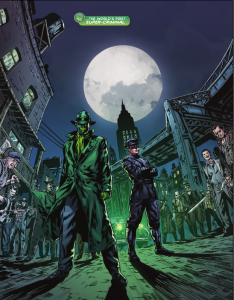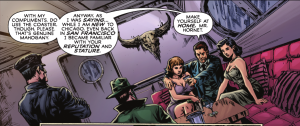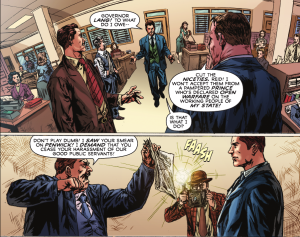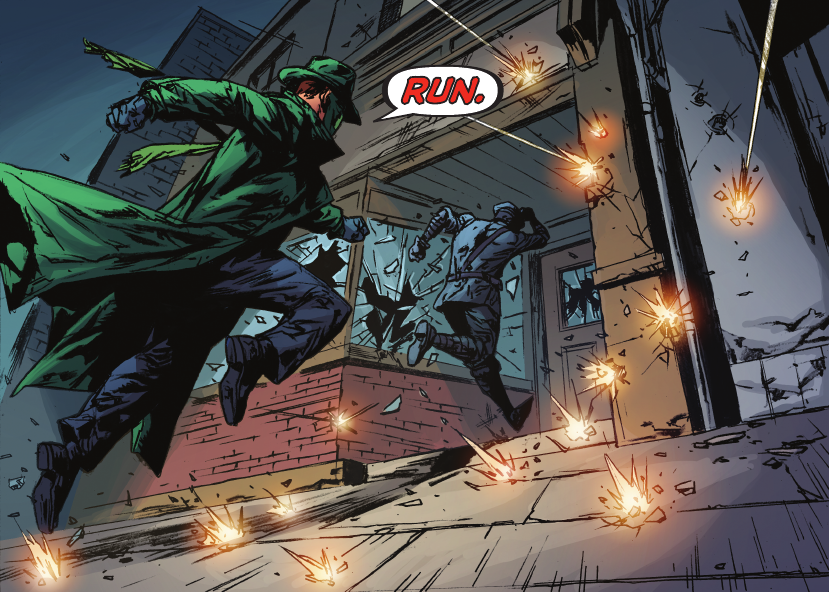As I mentioned in my John Carter first look, I’m somewhat new to Dynamite’s properties; more accurately, their licensed properties. When I attended the Pulp Panel at Baltimore Comic-Con 2014, I was interested in the Green Hornet for the first time. My only previous exposure was the trailer for the Seth Rogan film. I knew it was an old character from the time of the radio serials, but not much else. But after hearing about Mark Waid’s take on it, I flagged it as something to check out. Last time we looked at Kevin Smiths’ Green Hornet. This time we take a look at Mark Waid’s first two volumes. I don’t want to muddle things with comparisons, so I’ll just be taking a look at what Mark Waid did and, in about a month, there’ll be a comparison article.

As I did last time, I’d like to first quickly outline the story and then take a look at the themes Mark Waid is exploring. This time the story takes place in the 1940s, closer to the original Green Hornet stories. This allows Mark Waid to make use of pulp tropes and simpler technology. There are just some plots that don’t make sense in a world with Twitter, cell phones, the Internet, etc. The Green Hornet and Kato have been operating for a while, but not long enough that all the lowlifes know who they are. A new mob boss, Cerelli, arrives from San Francisco and already knows who The Green Hornet is, such is his infamy. In a plot that comes right out of the pulp era, The Green Hornet finds out that Axis power agents have infiltrated the USA and are trying to sabotage US efforts to assist the Europeans in the war. They are also waging a propaganda war to try and keep the US out of the war. Eventually Britt Reid figures out that the city’s industrialists are on the take as the Germans are paying them and they’re also collecting insurance on the goods they destroy. Additionally, it turns out that Cerelli is a German masquerading as an Italian. After The Green Hornet and Kato disrupt the German plot, they decide to retire as the events of this arc were hard to manage. Unfortunately, Lenore Case blackmails/guilt trips them into continuing. Thus we end with a proper pulp ending – the hero did some good, did some bad, and lost some of himself and his freedom in the process. (At least he’s alive at the end)
In addition to comparing The Green Hornet to Batman again, there are three themes I want to explore. The main theme is the theme of lies and deception. This is held up by the pillars of controlling information and a complexity that leads to a loss of control. These are central themes that Mark Waid likes to explore. Here are some relevant quotes from my 2012 interview with Mark Waid:
Me: Because for me the thing that brings in Jurassic Park is it seems like there’s a million places where the Plutonian could have been stopped, but people weren’t honest with each other. Or they had different agendas. And that’s kinda what keeps it going and it seems so real. Because the same thing happens in Jurassic Park, especially in the novel – the whole reason it kicks off is because people are being dishonest. Dennis Nedry shuts off the stuff and all that.
MW: Yeah, you’re absolutely right. I think that’s a big part of it. It’s not just about one guy and his foibles and all these other stellar, completely beyond reproach super heroes who have to stop him. It’s that watching his sins sort of exposes their own. Everybody has things they’ve done in the past that they regret, everybody has things they’ve done that are mistakes. When you watch them compound each other as they sort of realize from each others’ point of view how they’ve contributed to the overall problem, I think that’s what makes the narrative as strong as it is.
and later in the interview:
Me: The last geeky thing I wanted to ask you before we circle back around to Thrillbent: I noticed, at least between these two titles, I haven’t read your Daredevil or some of your older material, but you seem to have a big focus on themes of trust and themes of infidelity. For example, Bette and the Plutonian and in Insufferable – we haven’t seen the consequences yet – but Nocturnus he stole someone’s wife who became Galahad’s mom.
MW: Yeah, I gotta say, when you put it that way I never really thought about it, but I guess those are honest themes in all of my work because I really believe that the most destructive things that people can do (we get interrupted by an announcement made over the PA). Alright, here’s the thing, if you think of super hero comics and the entire medium of super hero comics as an inverted pyramid then at the very apex is the concept that Superman can put on glasses and live among us and not tell us who he really is. And there’s pluses and minuses to that. And I think that my fascination with this idea secrets – the way you keep secrets in the super hero universe – secret identities and secret alter-egos and secret powers – has always been a fascination to me. So it makes sense that the most dramatic stories I can tell are the ones where people aren’t honest with each other or don’t tell each other everything they need to know. And even the simplest omissions of fact can lead to huge, horrible consequences. So that, to me, that’s the huge part of a lot of the drama that I write.

The most basic deception, of course, is that of Britt Reid and Kato playing super-criminal. In a lot of ways, this is the least interesting deception on its own. Of course, it is this deception that leads Britt to act upon his assumed identity and set in motion the complexity and loss of control. What I find more interesting are the contrasting deceptions carried out by Cerelli and the Chicago industrialists. Both are working for the German cause, but present quite different fronts. Cerelli tries to mask his seditious work by hiding in other illegitimate work. It allows him to operate among shady characters without attracting any extra attention. This works extra well because the police are already corrupt so they wouldn’t pay another mobster much attention as long as the mobster paid their bills. Also, his supposed racket is importing weapons, so if the Germans needed weapons, it wouldn’t arouse suspicion. On the opposite end are the industrialists. In the USA we’ve had a split personality view of the rich for a while. We are never surprised to hear about decadence, perversion, and white collar crime. At the same time, these people command respect and are often offered perks like being able to turn themselves in and another chance at life rather than being ruined in prison.

Key to the ability to run the deception campaigns is being able to control the flow of information. Britt Reid runs what appears to be one of the most widely read newspapers we’ve been conditioned to find information to be more truthful if it’s on paper. Additionally, a newspaper is supposed to have editorial checks to make sure it isn’t printing falsehoods. (Although, that has only been the case in a small portion of the history of newspapers in the USA) So Reid has an enormous power with his newspaper to guide what the public thinks as well as their outrages. He often strives to use this power for good and even uses the leads he gets as The Green Hornet to print headlines that move the public to push the police and government officials to investigate things. This can lead to some issues and Mark Waid is a smart enough writer to have Ried face some difficulties to allow our suspension of disbelief not be stretched to the limit. For example, Reid is manipulated into accusing a family friend of being a Nazi sympathizer and then when he’s revealed to be wrong, it makes it seem as though he did it for personal gain – to become mayor. (Which the same people had pushed him into) Additionally, it was tough for me to believe that the criminal underworld wouldn’t realize that secrets only The Green Hornet knew ended up in the newspaper. Reid is lucky his reputation and violence make most of those at the top dismiss the notion. Reid is not the only newspaper in town and his rival are not above using tricks and photo opportunities to make Reid look bad.
When the board threatens to kick Reid out, he quits and buys a radio station. He talk a lot about it being the medium of the future, which it was at the time. It also makes a lot of sense for what Reid wishes to accomplish. A radio station is orders of magnitude faster than a newspaper in getting new information out to the public. Most newspapers need the morning’s news printed the night before in order to have it ready for press time. While some newspapers printed morning and evening editions back before TV and the Internet, the news is still always several hours old. With a radio station Reid can run circles around his newspaper rivals. Radio also allows for the emotion of voice to be transmitted along with the words, causing people to be more easily stirred to action.
Finally, Reid sets up a proto-Internet by ordering news service terminals from around the world. It was the fastest way to get information before satellite transmissions. This allows him to know what’s going on around the world right away. While this would be overkill for most local heroes, given this story involves Nazis, this level of information flow is important.
These two themes lead us to another Waid favorite – the chaos of complex plans. As The Green Hornet continues to spin lies and deceptions, more and more of Chicago is thrown into the web and he starts having to deal with the chaos added by human interaction. For example, when he’s trapped in a basement he attempts to corrupt the last honest cop on the force. He mentions the man’s wife needs medical treatment and the money will help. The cop accepts the money and Kato asks Hornet if he’s perhaps set something bad into motion by getting rid of the last good cop. Then we cheer as he later gives the money back to The Green Hornet – he was incorruptible! But it turns out his wife didn’t find his honesty to be so noble when she was dying. She kills herself and if that wasn’t enough to put him over the edge, Reid has Casey offer him the money through legitimate means right after his wife kills herself. He becomes an uncontrollable sociopath that causes Reid all kinds of grief – even though he’s working FOR The Green Hornet. Eventually Hornet is forced to have him jailed by making it seem as though he killed his wife (rather than her suicide).
Additionally, one of the negative aspects of The Green Hornet being as masked man is that anyone can pretend to be The Green Hornet. So he has to deal with a counterfeit Hornet who’s forcing kids to work for him and threatening to ship them off to be sex slaves in Asia. After he deals with that, he’s once again stuck dealing with a Green Hornet imposter problem right as he and Kato decide to retire. It turns out that Casey has purposely donned the costume to get herself arrested. She is addicted to information and to the thrill of stopping crime so she wants to get information from criminals in jail. Finally, she’s blackmailed Reid because if he doesn’t continue now, he’s saying she went to jail in vain.
As I did last time, I’d like to make some comparisons with Batman, The Green Hornet’s pulp contemporary. On a basic level, Waid has Reid gain a sort of arrogance and overconfidence that leads him to believe his mission to be so righteous he often puts them above his relationships – the very same relationships that keep him sane and keep him grounded. In this iteration, Kato plays the dual roles analogous to both Robin and Alfred. Especially important within this story is his Alfred role as Reid’s conscious. Finally, Casey is made into a 1940s version of The Oracle. Not only is she responsible for combing the proto-Internet, but she also keeps track of where the cops and his rival are in real time.
So, there you go. We’ve now seen a modern Green Hornet and a period piece Green Hornet. In a little over a month we’ll have the big compare and contrast article.
I’d love to hear your thoughts in the comments!
The Green Hornet Vol 1 written by Mark Waid with art by Daniel Indro and Ronilson Freire and colored by Marcio Menyz. Lettered by Troy Peteri.

[…] at the same time many of them certainly have a time and place in which they belong. For example, Mark Waid’s Green Hornet takes place in the 1940s and Hornet definitely works well in that time period, but the story is […]